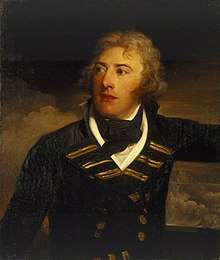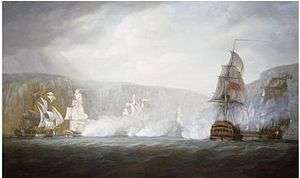Joseph Sydney Yorke
Admiral Sir Joseph Sydney Yorke KCB (6 June 1768 – 5 May 1831) was an officer of the Royal Navy. As a junior officer he saw action at the Battle of the Saintes in April 1782 during the American Revolutionary War. He commanded HMS Stag at the defeat of the Dutch fleet in August 1795 during the French Revolutionary Wars and went on to be First Naval Lord during the closing stages of the Napoleonic Wars.
Sir Joseph Sydney Yorke | |
|---|---|
 Sir Joseph Sydney Yorke | |
| Born | 6 June 1768 London |
| Died | 5 May 1831 (aged 62) Spithead |
| Allegiance | United Kingdom of Great Britain and Ireland |
| Service/ | Royal Navy |
| Years of service | 1780–1831 |
| Rank | Admiral |
| Commands held |
|
| Battles/wars | Battle of the Saintes |
| Awards |
|
| Relations |
|
Family and early life
Yorke was born in Great Berkhampstead, Hertfordshire, on 6 June 1768, the second son, by his second marriage, of the politician Charles Yorke.[1] He joined the navy at the age of 11, becoming a midshipman aboard HMS Duke, then under the command of Sir Charles Douglas, on 15 February 1780. He followed Douglas to his next command, HMS Formidable, which flew the flag of Admiral George Rodney.[1] Yorke was then present at Rodney's victory over François Joseph Paul de Grasse at the Battle of the Saintes from 9 to 12 April 1782. The end of the American Revolutionary War led to the Formidable returning to Britain to be paid off. Yorke remained in employment however, transferring with Douglas to HMS Assistance, and then moving to HMS Salisbury, under the command of Sir Erasmus Gower, filling the post of master's mate. Yorke spent three years in total serving on the Newfoundland Station.[1]
Promotions
Yorke was promoted to lieutenant on 16 June 1789, and moved aboard the 50-gun HMS Adamant to serve under Admiral Sir Richard Hughes.[1] He later served as lieutenant aboard HMS Thisbe and HMS Victory and in February 1791 he was appointed master and commander of the sloop HMS Rattlesnake. He remained aboard her, carrying out cruises into the English Channel until the outbreak of war with France in 1793. He was promoted to Post-Captain on 4 February 1793 and given command of the frigate HMS Circe, then part of a squadron under Admiral Richard Howe. He patrolled off the French port of Brest, and captured the corvette L'Espiegle.[1]

Yorke moved to HMS Stag in July 1794, and continued to serve in the Channel, occasionally ranging into the North Sea. On 22 August 1795 the Stag and a small British squadron chased two large ships and a cutter, eventually bringing the sternmost one to battle. An hour-long fight ensued, after which the enemy, subsequently found to be the Batavian frigate Alliance, was forced to surrender.[1] Yorke moved to command the newly built HMS Jason in March 1800, and by 1801 was in command of the 74-gun third rate HMS Canada. He commanded her until the Treaty of Amiens in 1802 brought a period of temporary peace.[1] On the resumption of the war in 1803 Yorke was appointed to the 98-gun HMS Prince George, followed by HMS Barfleur and then HMS Christian VII, an 80-gun former Danish ship captured at the Battle of Copenhagen in 1807.[1][2][3]
Knighthood and flag rank
Yorke was knighted during this period of service, on 21 April 1805, by King George III.[4] On 23 April, Yorke was present at the installation of the Knights of the Garter, standing in for his brother, Philip Yorke, Earl of Hardwicke.[5] Philip was at this time Lord Lieutenant of Ireland, and so was unable to be present in person.[1] In 1810 Joseph Yorke's brother, Charles Philip Yorke became First Lord of the Admiralty and Joseph was transferred from command of the Christian VII to take up a seat on the Board of Admiralty.[1]
Joseph Yorke was promoted to Rear-Admiral of the Blue on 31 July 1810 and hoisted his flag in the 74-gun HMS Vengeance in January 1811.[1] He sailed to the Tagus carrying reinforcements for Arthur Wellesley's army, fighting in the Peninsular War.[1] After carrying this out he escorted a fleet returning to Britain from the East Indies. Yorke was promoted to Rear-Admiral of the White on 12 August 1812,[6] Rear-Admiral of the Red on 4 December 1813[7] and Vice-Admiral of the Blue on 14 June 1814.[8] He served as First Naval Lord in the Liverpool ministry from October 1813 until May 1816[9] but remained on the Admiralty Board until April 1818.[10] He was appointed a Knight Commander of the Order of the Bath (KCB) in the restructuring of that order in January 1815,[11] promoted Vice-Admiral of the White on 12 August 1819,[12] and promoted to Admiral of the Blue on 22 July 1830.[13]
Parliamentary career
Yorke stood as a candidate for the constituency of Reigate in 1790, and was returned as its member.[1][14] He represented the borough[15] until 1806, when he was elected as member for St Germans.[16] He stood aside, "taking the Chiltern Hundreds" in 1810 so that his brother, Charles Philip Yorke, could be elected.[17] In the 1812 general election Joseph Yorke stood as a candidate for Sandwich and was returned as its member.[1] He represented the borough until 1818 when he was re-elected to the Reigate constituency, which he represented until his death.[18] Yorke's business interests include the chairmanship of the Waterloo Bridge Company.[1]
Family and personal life
On 29 March 1798, Yorke married Elizabeth Weake Rattray, the daughter of James Rattray, in Ireland. The couple had a number of children before Elizabeth's death on 20 January 1812.[1] His eldest son, Charles Yorke also served in the navy, rising to the rank of admiral, and on the death without heir of Joseph Yorke's brother Philip, the 3rd Earl of Hardwicke in 1834, Charles became the 4th Earl. His daughter Agneta Elizabeth Yorke married the banker Robert Cooper Lee Bevan.[19]
On 22 May 1813, Joseph married a second time, to Urania Anne, the Dowager Marchioness of Clanricarde, and daughter of George Paulet, 12th Marquess of Winchester, at St. Martin in the Fields, Westminster, London. The marriage did not produce any children.[1]
Death
On 5 May 1831 Yorke was returning from visiting Henry Hotham's flagship, HMS St Vincent, then moored at Spithead. He was making his way back to shore aboard the yacht Catherine, in company with Captains Matthew Barton Bradby and Thomas Young, and a seaman named John Chandler, when the boat was struck by lightning in Stokes Bay, causing it to capsize.[1][20] All aboard were drowned. The bodies were later recovered and an inquest returned a verdict of accidental death.[1] Yorke was buried at the family tomb in the parish church at Wimpole, close to Wimpole Hall, the seat of the Earls of Hardwicke.[1][21]
References
- United Service Magazine. pp. 215–217.
- "No. 16352". The London Gazette. 17 March 1810. p. 406.
- James, William (1824). "Vol. 5". The Naval History of Great Britain: From the Declaration of War by France in February 1793, to the accession of George IV in January 1820; with an account of the origin and progressive increase of the British Navy. London: Baldwin, Cradock and Joy. pp. 333–335.
- "No. 15809". The London Gazette. 21 May 1805. p. 683.
- "No. 15800". The London Gazette. 23 April 1805. p. 550.
- "No. 16632". The London Gazette. 11 August 1812. p. 1584.
- "No. 16821". The London Gazette. 4 December 1813. p. 2432.
- "No. 16906". The London Gazette. 7 June 1814. p. 1187.
- Rodger, p. 69
- "Sainty, JC, Lord High Admiral and Commissioners of the Admiralty 1660–1870, Office-Holders in Modern Britain: Volume 4: Admiralty Officials 1660–1870 (1975), pp. 18–31". Archived from the original on 7 October 2014. Retrieved 4 September 2009.
- "No. 16972". The London Gazette. 4 January 1815. p. 19.
- "No. 17505". The London Gazette. 12 August 1819. p. 1446.
- "No. 18709". The London Gazette. 23 July 1830. p. 1539.
- "No. 13217". The London Gazette. 10 July 1790. p. 433.
- "No. 15497". The London Gazette. 13 July 1802. p. 747.
- "No. 15976". The London Gazette. 18 November 1806. p. 1506.
- "No. 16366". The London Gazette. 1 May 1810. p. 644.
- "No. 18719". The London Gazette. 20 August 1830. p. 1783.
"No. 18802". The London Gazette. 10 May 1831. p. 901. - "Bevan, Robert Cooper Lee (1809–1890)". ODNB. Retrieved 5 August 2015.
- Laughton, ODNB
- "Melancholy Death of Sir Joseph Yorke 1768–1831". The Times. 9 May 1831. Archived from the original on 8 September 2008. Retrieved 18 September 2008. (Announcement in The Times, p.3, reproduced at www.wimpole.info
Sources
- "The Services of the late Admiral Sir Joseph Sydney Yorke". The United Service Magazine. 1831. pp. 215–217.
- J. K. Laughton, ‘Yorke, Sir Joseph Sydney (1768–1831)’, rev. Andrew Lambert, Oxford Dictionary of National Biography, Oxford University Press, 2004, doi:10.1093/ref:odnb/30244. The first edition of this text is available at Wikisource: . Dictionary of National Biography. London: Smith, Elder & Co. 1885–1900.
- Rodger, N.A.M. (1979). The Admiralty. Offices of State. Lavenham: T. Dalton Ltd. ISBN 0900963948.
External links
- Hansard 1803–2005: contributions in Parliament by Joseph Sydney Yorke
- Yorke's entry in thepeerage.com
- Copy of the announcement of the deaths in The Times
- Portrait and short biography of Yorke at the National Maritime Museum
| Military offices | ||
|---|---|---|
| Preceded by William Domett |
First Naval Lord 1813–1816 |
Succeeded by Sir Graham Moore |
| Parliament of Great Britain | ||
| Preceded by Reginald Pole-Carew The Lord Hood |
Member of Parliament for Reigate 1790–1801 With: John Somers Cocks |
Succeeded by (Parliament of the United Kingdom) |
| Parliament of the United Kingdom | ||
| Preceded by (Parliament of Great Britain) |
Member of Parliament for Reigate 1801–1806 With: John Somers Cocks 1801–1806 Philip James Cocks 1806 |
Succeeded by Edward Charles Somers Cocks Viscount Royston |
| Preceded by Lord Binning James Langham |
Member of Parliament for St Germans 1806–1810 With: Matthew Montagu |
Succeeded by Charles Philip Yorke Matthew Montagu |
| Preceded by Ralph Allen Daniell James Buller |
Member of Parliament for West Looe January–October 1812 With: Ralph Allen Daniell |
Succeeded by Charles Buller Anthony Buller |
| Preceded by John Spratt Rainier Charles Jenkinson |
Member of Parliament for Sandwich 1812–1818 With: Joseph Marryatt |
Succeeded by Joseph Marryatt Sir George Warrender |
| Preceded by James Cocks John Somers Cocks |
Member of Parliament for Reigate 1818–1831 With: James Somers Cocks 1818–1823 James Cocks 1823–1831 Joseph Yorke 1831 |
Succeeded by Joseph Yorke Charles Philip Yorke |